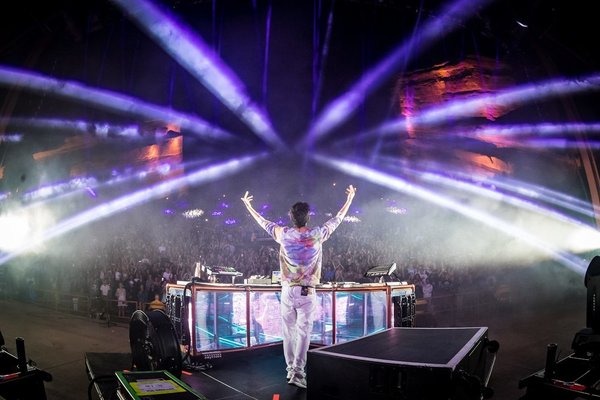When electronic music producer Flume returned to Red Rocks in July 2017, a large complement of Claypaky Sharpys, grandMA2 light consoles and MDG theONE atmospheric generators helped the Grammy winner light up the iconic Colorado amphitheatre.
Flume, the professional name of Harley Edward Streten, enjoyed a successful Red Rocks debut in 2016. A year later he added the date to an already impressive American tour during which he headlined at Bonnaroo, CRSSD and Electric Forest, while winning a Grammy for Best Dance/Electronic Album for his second LP, Skin, in the meantime.
Note Productions provided the equipment, which is distributed exclusively in North America by A.C.T Lighting. Assigned LD Stu Dingley was charged with creating a design that reflected the musician’s new and unique musical sub-genre and helped deliver “an experience [for the audience] that left a lasting identity to associate with Flume and his brand. It had to be thoughtful and precise without falling into anything too cliché EDM.”
Production Designer Rob Sinclair crafted scenic elements of neon-lit glass cubes and booth working alongside Creative Director Jonathan Zawada while Chris Rupple was the Lighting Crew Chief and Joel Eriksson was the Production Manager.
Utilising 46 Sharpys for Red Rocks, 16 Sharpys on the floor forming 2 horizontal lines at offset heights backing the artist. Thirty more were mounted overhead and kept in reserve for heavier electronic moments in the show, including 36 Sharpy washes, deploying 4 as side key lights and 32 overhead.
Dingley also had two grandMA2 lights and two NPUs at Red Rocks. “As far as workflow, the MA2 platform is very logical to me. Flume’s show is heavily reliant on timecode and audio triggers. It is easy to come up with an aesthetic idea when talking with the artist, while simultaneously visualising how it will work on a practical level. For example, we have a continuing theme of a ‘Weapon’ soundscape intertwined throughout the set. It is far too abstract to run timecode over it, and most of the sounds are created live. We can link an audio frequency band from the waveform and trigger a corresponding effect. Being able to confidently deliver a concept is invaluable when brainstorming ideas.”
Dingley explained: “For the rest of the show, timecode is chopped into hundreds of loops and assigned all over the Ableton session. Being able to work on a horizontal timeline opens a lot of possibilities when trying to hit all the sounds and layer up moments throughout the show. If [Flume] decides to jump ahead, skip a verse, jump into a new track for example, the console picks it up far quicker than an operator would.”
A pair of MDG theOne atmospheric generators is also featured in Flume’s show. “They really are the best units out there. In arenas, they create a beautifully clean and cloud-free haze. The small particle size makes the haze almost disappear to the eye, which really helps keep the video walls sharp. Then, in complete contrast, when we get to outdoor festival stages, we toggle in the fog mode and really wipe out the field,” Dingley concluded.






